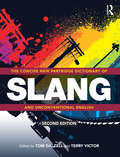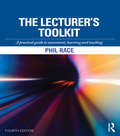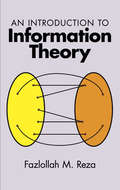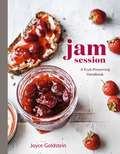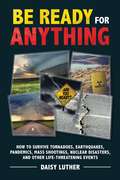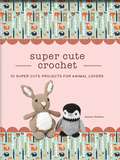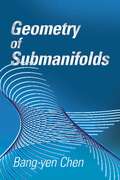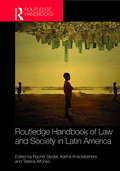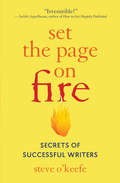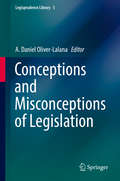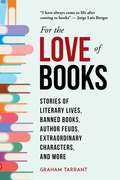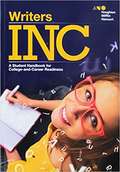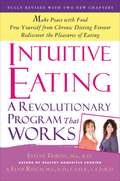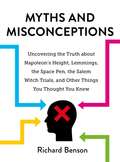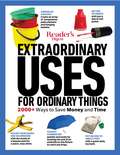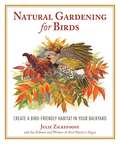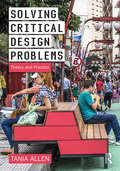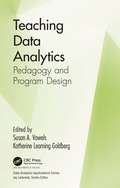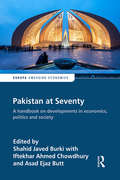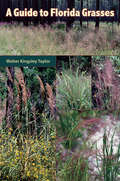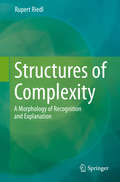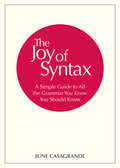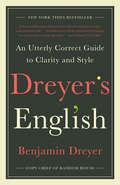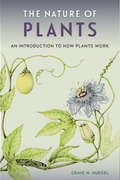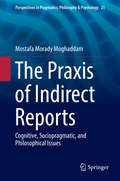- Table View
- List View
The Concise New Partridge Dictionary of Slang and Unconventional English
by Tom Dalzell Terry VictorThe Concise New Partridge Dictionary of Slang and Unconventional English presents all the slang terms from The New Partridge Dictionary of Slang and Unconventional English in a single volume. Containing over 60,000 entries, this concise new edition of the authoritative work details the slang and unconventional English of from around the English-speaking world since 1945, and through the first decade of the new millennium, with the same thorough, intense, and lively scholarship that characterized Partridge’s own work. Unique, exciting and, at times, hilariously shocking, key features include: unprecedented coverage of World English, with equal prominence given to American and British English slang, and entries included from Australia, New Zealand, Canada, India, South Africa, Ireland, and the Caribbean emphasis on post-World War II slang and unconventional English dating information for each headword in the tradition of Partridge, commentary on the term’s origins and meaning. New to this second edition: a new preface noting slang trends of the last eight years over 1,000 new entries from the US, UK and Australia, reflecting important developments in language and culture new terms from the language of social networking from a range of digital communities including texting, blogs, Facebook, Twitter and online forums many entries now revised to include new dating and new glosses, ensuring maximum accuracy of content. The Concise New Partridge Dictionary of Slang and Unconventional English is a spectacular resource infused with humour and learning – it’s rude, it’s delightful, and it’s a prize for anyone with a love of language.
The Lecturer's Toolkit: A practical guide to assessment, learning and teaching
by Phil RaceThe Lecturer’s Toolkit is a wide-ranging, down-to-earth, practical resource for lecturers and teachers in universities and colleges. Jargon-free and written with authority, clarity and candour, the Toolkit addresses a broad range of aspects of assessment, feedback, learning and teaching, and helps develop many facets of professional practice. Built around a central agenda of improving the quality of student learning, the Toolkit is outcomes-focused. Building on the strengths of its predecessors, this fourth edition includes strengthened emphasis on assessment and feedback, and designing large-group teaching for the digital age, when students can get easy access to a vast range of learning resource materials online. Coverage includes: how students really learn; designing assessment and feedback to enhance learning; lectures in the digital age; making small-group teaching work; resource-based learning in the digital age; looking after yourself; challenges and reflections. Fully updated and expanded, this fourth edition of the Toolkit will be an essential and flexible resource for every higher education professional.
An Introduction to Information Theory (Dover Books on Mathematics)
by Fazlollah M. RezaWritten for an engineering audience, this book has a threefold purpose: (1) to present elements of modern probability theory — discrete, continuous, and stochastic; (2) to present elements of information theory with emphasis on its basic roots in probability theory; and (3) to present elements of coding theory.The emphasis throughout the book is on such basic concepts as sets, the probability measure associated with sets, sample space, random variables, information measure, and capacity. These concepts proceed from set theory to probability theory and then to information and coding theories. No formal prerequisites are required other than the usual undergraduate mathematics included in an engineering or science program. However, since these programs may not include a course in probability, the author presents an introductory treatment of probability for those who wish to pursue the general study of statistical theory of communications. The book is divided into four parts: memoryless discrete themes, memoryless continuum, schemes with memory, and an outline of some recent developments. An appendix contains notes to help familiarize the reader with the literature in the field, while the inclusion of many reference tables and an extensive bibliography with some 200 entries makes this an excellent resource for any student in the field.
Jam Session: A Fruit-Preserving Handbook
by Joyce GoldsteinThe right-sized handbook for fruit preserving, with 75 basic and special recipes for jams, jellies, chutneys, and compotes, by chef emeritus and master preserver Joyce Goldstein. Jam Session is the lushly photographed and selective guide to making all-natural fruit preserves, organized by type of fruit and seasonal availability, with descriptions of the best varieties for preserving plus master recipes and contemporary variations for each type of fruit. Former restaurant chef/owner, culinary historian, and master preserver Joyce Goldstein includes straightforward, no-fail instructions for canning fruit preserves, along with serving ideas for using preserves for much more than toast, including Mango-Lime Jam to elevate pork tenderloin, Pickled Peaches to perk up fried chicken, and Apricot Jam to glaze cake. Packed with ideas, 75 time-tested recipes, and gorgeous photographs of produce, process, and finished fruit preserves, preserving newcomers and veterans alike will find Goldstein's handbook just the right amount of instruction and inspiration.
Be Ready for Anything: How to Survive Tornadoes, Earthquakes, Pandemics, Mass Shootings, Nuclear Disasters, and Other Life-Threatening Events
by Daisy LutherWill you be a ready for a dozen different kinds of disasters? You want to be prepared for whatever emergencies come your way. While prepping for a dozen different disasters may sound like a daunting task, there’s good news. Preparing for a wide variety of disasters requires the same basic supplies as preparing for one or two. For each event, there will be some special steps, unique information, and precautions you need to take, along with a few additional supplies, but your essentials will be the same. Learn how to prepare for: Earthquakes Tornadoes Hurricanes Winter Storms Wildfire Evacuations Pandemics Nuclear Disasters Mass Shootings Civil Unrest Economic Crises And More! With directions, helpful appendices, checklists, and general guidance to getting prepped, this book will get you away from panic and straight to safety.
Super Cute Crochet: 10 Super Cute Projects for Animal Lovers (Crochet Kits)
by Janine HolmesYou’ll be hooked on these ten super cute crochet animals!Super Cute Crochet contains photos and illustrations to guide you in making ten super cute projects: including a panda, penguin, koala, lamb, sloth, llama, unicorn, hedgehog, piglet, and bunny. If you squeal with delight over furry and fuzzy creatures, you’ll be hooked on making these animals.
Geometry of Submanifolds (Dover Books on Mathematics)
by Bang-Yen ChenThe first two chapters of this frequently cited reference provide background material in Riemannian geometry and the theory of submanifolds. Subsequent chapters explore minimal submanifolds, submanifolds with parallel mean curvature vector, conformally flat manifolds, and umbilical manifolds. The final chapter discusses geometric inequalities of submanifolds, results in Morse theory and their applications, and total mean curvature of a submanifold.Suitable for graduate students and mathematicians in the area of classical and modern differential geometries, the treatment is largely self-contained. Problems sets conclude each chapter, and an extensive bibliography provides background for students wishing to conduct further research in this area. This new edition includes the author's corrections.
Routledge Handbook of Law and Society in Latin America
by Rachel Sieder Karina Ansolabehere Tatiana A. Alfonso SierraAn understanding of law and its efficacy in Latin America demands concepts distinct from the hegemonic notions of "rule of law" which have dominated debates on law, politics and society, and that recognize the diversity of situations and contexts characterizing the region. The Routledge Handbook of Law and Society in Latin America presents cutting-edge analysis of the central theoretical and applied areas of enquiry in socio-legal studies in the region by leading figures in the study of law and society from Latin America, North America and Europe. Contributors argue that scholarship about Latin America has made vital contributions to longstanding and emerging theoretical and methodological debates on the relationship between law and society. Key topics examined include: The gap between law-on-the-books and law in action The implications of legal pluralism and legal globalization The legacies of experiences of transitional justice Emerging forms of socio-legal and political mobilization Debates concerning the relationship between the legal and the illegal. The Routledge Handbook of Law and Society in Latin America sets out new research agendas for cross-disciplinary socio-legal studies and will be of interest to those studying law, sociology of law, comparative Latin American politics, legal anthropology and development studies.
Set the Page on Fire: Secrets of Successful Writers
by Steve O'KeefeDiscover the Tricks and Tools of the Pros Successful writers write, rather than just think about writing, talk about writing, or plan what they’ll write when they get a cabin in the woods. Yet even accomplished writers sometimes get “blocked,” losing access to their in-the-zone writing mind. Steve O’Keefe offers proven techniques and practices for jump-starting stalled ideas, honed during his many years of working in virtually every aspect of publishing. His innovative, often unconventional exercises will get you writing and accessing your own unique voice — a voice the world wants to read! Containing a career’s worth of writing and publishing savvy, as well as the advice of expert authors gleaned from hundreds of interviews, Set the Page on Fire is the kind of nuts-and-bolts coaching and encouragement invaluable to novice and veteran writers alike.
Conceptions and Misconceptions of Legislation (Legisprudence Library #5)
by A. Daniel Oliver-LalanaThis volume brings together an international group of legal scholars to discuss different approaches to lawmaking. As well as reflecting the diversity of legisprudence as a re-emerging academic field, it offers a broad overview of current developments and challenges in the theory of legislation, and aspires, moreover, to counterbalance some questionable ideas or misconceptions, widespread among jurists, on what making laws entails. The book is organized into three parts. The first comprises a sample of ‘ways and models of legislation’, ranging from classic legislative ideals to contemporary forms of regulation. The essays in this part, variances of focus notwithstanding, revolve around the notions of legislative rationality, quality, effectiveness, and legitimacy, which may be regarded as the cornerstones of legisprudence. Interwoven with these notions is another core legisprudential concern: the justification of laws. We address it separately in the next part by exploring the connection between lawmaking, argumentation and constitutional democracy: under the heading ‘legislation in a culture of justification’, a number of aspects of this connection are tackled that have not been sufficiently considered so far in legisprudential literature, such as the intricacies of legislative reasoning and balancing, or the justificatory problems posed by special-interest legislation. The under privileged status of legisprudence in legal studies and the need for socially attentive and citizen-oriented legislative research come to the fore in the third part of the book which turns to the relationships between ‘legisprudence, lawyers, and citizens’. All in all, the thirteen articles gathered here provide a stimulating insight into the theory of legislation, and can hopefully contribute to the reconciliation of the study of law and the study of its making.
For the Love of Books: Stories of Literary Lives, Banned Books, Author Feuds, Extraordinary Characters, and More
by Graham TarrantA light-hearted book about books and the people who write them for all lovers of literature. Do you know: Which famous author died of caffeine poisoning?Why Alice’s Adventures in Wonderland was banned in China?Who was the first British writer to win the Nobel Prize in Literature?What superstitions Truman Capote kept whenever he wrote?Who the other Winston Churchill was? A treasure trove of compelling facts, riveting anecdotes, and extraordinary characters, For the Love of Books is a book about books—and the inside stories about the people who write them. Learn how books evolved, what lies behind some of the greatest tales ever told, and who’s really who in the world of fiction. From banned books to famous feuding authors, from literary felons to rejected masterpieces, from tips for aspiring writers to stand-out book lists for readers to catch up on, For the Love of Books is a celebration of the written word and an absolute page-turner for any book lover. Read all about it!
Writers Inc: Student Handbook For College-and-Career Readiness
by Houghton Mifflin Harcourt StaffWriters INC Student Handbook is thoughtfully designed with college-and-career readiness in mind, starting with all facets of writing—from constructing sentences and paragraphs to developing academic essays. Explanatory essays and essays of argumentation are included, as are responses to literature and many narrative forms. There are also special sections on writing across the curriculum, social media, updated MLA and APA guidelines, and test taking skills to help students’ master new performance-based assessments.
Intuitive Eating: A Revolutionary Program That Works
by Evelyn Tribole Elyse ReschFirst published in 1995, Intuitive Eating has become the go-to book on rebuilding a healthy body image and making peace with food. We've all been there, angry with ourselves for overeating, for our lack of willpower, for failing at yet another diet. But the problem is not us; it's that dieting, with its emphasis on rules and regulations, has stopped us from listening to our bodies. Written by two prominent nutritionists, Intuitive Eating will teach you: * How to reject diet mentality forever *How our three Eating Personalities define our eating difficulties * How to find satisfaction in your eating * How to feel your feelings without using food * How to honor hunger and feel fullness * How to follow the ten principles of "Intuitive Eating", * How to achieve a new and safe relationship with food and, ultimately, your body * How to raise an "intuitive eater"--NEW! * The incredible science behind intuitive eating--NEW! This revised edition includes updates and expansions throughout, as well as two brand new chapters that will help readers integrate intuitive eating even more fully into their daily lives.
Myths and Misconceptions: Uncovering the Truth about Napoleon's Height, Lemmings, the Space Pen, the Salem Witch Trials, and Other Things You Thought You Knew
by Richard BensonHave you always thought that a goldfish has a 3-second memory span? Do you think your morning coffee comes from a bean? Do you believe that those accused at the Salem Witch Trials were burned at the stake? If the answer to any of these questions is yes, then you’ve been lied to. But don’t worry, this book will set the record straight on all the common myths that most people take for fact, making you the most well-informed smart-alec in town. So next time someone proclaims that Napoleon Bonaparte was short, or that shaving causes hair to grow back thicker, you can correct them, and tell them smugly that everything they think they know is wrong.
Reader's Digest Extraordinary Uses for Ordinary Things New Edition
by Reader'S DigestAn updated edition, now fully illustrated and in color, of the classic guide to using common household items to replace, restore, repair, or revive almost anything in your household—including yourself.When you have a household problem, don’t run to the store and waste good money, just open your pantry door—and EXTRAORDINARY USES FOR ORDINARY THINGS. You’ll be amazed at what you can do with baby oil, bleach, duct tape, tea, rubbing alcohol, and dozens of other handy items. This book will open your eyes to more than 2,000 creative and helpful uses you can make of familiar household products, such as: • Aspirin can revive a dead car battery and a coating of petroleum jelly will keep the battery’s terminals from corroding • A dab of shaving cream can keep your bathroom mirror from fogging and can remove juice stains on carpeting • Petroleum jelly makes a great lip balm, makeup remover, and moisturizer • A turkey baster is the perfect tool for watering Christmas trees and hard-to-reach plants • Beer can be combed through your hair as a setting lotion, used as lure to trap insects, and polish gold jewelry • Sandpaper can be used to sharpen needles and scissors, roughen slippery soles of new shoes, remove ink stains and scuff marks from suede, and remove stains on grout lines • Wax paper will prevent a cast-iron skillet from rusting, restore the nonstick surface on your iron, and use on the bottom of a microwave when cooking messy foods. If you hate to throw things away or if you delight in dreaming up new ways to use ordinary items, then you’ll love the ideas in this book. You’ll be amazed at the problems you can solve. It’s a book you’ll be sure to turn to again and again for helpful ideas, trustworthy advice, and entertaining reading.
Natural Gardening for Birds: Create a Bird-Friendly Habitat in Your Backyard (Rodale Organic Gardening Book Ser.)
by Julie ZickefooseA Practical Illustrated Bird-Oriented Gardening Book with Great Reference ChartsBird-watchers everywhere dream of a landscape dotted with fruiting shrubs, nests tucked into twining vines, and birds flocking to feeding stations. Let Natural Gardening for Birds show you how to lay out the welcome mat for birds by considering all of their needs, including year-round food, water, and shelter. Whether you’re looking to create a hummingbird garden, install a water feature, create alluring perches, or simply designate a corner of your property as a natural area, you’ll find all the inspiration and information you need in Natural Gardening for Birds, including:The best plants for nectar, fruit, and seedsThe most attractive foods to offer birdsHousing for cavity-nesting birdsSimple habitat enhancements like snags and perchesRegion-specific planting ideas and charts
Solving Critical Design Problems: Theory and Practice
by Tania AllenSolving Critical Design Problems demonstrates both how design is increasingly used to solve large, complex, modern-day problems and, as a result, how the role of the designer continues to develop in response. With 13 case studies from various fields, including program and product design, Tania Allen shows how types of design thinking, such as systems thinking, metaphorical thinking, and empathy, can be used together with methods, such as brainstorming, design fiction, and prototyping. This book helps you find ways out of your design problems by giving you other ways to look at your ideas, so that your designs make sense in their setting. Solving Critical Design Problems encourages a design approach that challenges assumptions and allows designers to take on a more critical and creative role. With over 100 images, this book will appeal to students in design studios, industrial and product design, as well as landscape and urban design.
Teaching Data Analytics: Pedagogy and Program Design (Data Analytics Applications)
by Susan A Vowels Katherine Leaming GoldbergThe need for analytics skills is a source of the burgeoning growth in the number of analytics and decision science programs in higher education developed to feed the need for capable employees in this area. The very size and continuing growth of this need means that there is still space for new program development. Schools wishing to pursue business analytics programs intentionally assess the maturity level of their programs and take steps to close the gap. Teaching Data Analytics: Pedagogy and Program Design is a reference for faculty and administrators seeking direction about adding or enhancing analytics offerings at their institutions. It provides guidance by examining best practices from the perspectives of faculty and practitioners. By emphasizing the connection of data analytics to organizational success, it reviews the position of analytics and decision science programs in higher education, and to review the critical connection between this area of study and career opportunities. The book features: A variety of perspectives ranging from the scholarly theoretical to the practitioner applied An in-depth look into a wide breadth of skills from closely technology-focused to robustly soft human connection skills Resources for existing faculty to acquire and maintain additional analytics-relevant skills that can enrich their current course offerings. Acknowledging the dichotomy between data analytics and data science, this book emphasizes data analytics rather than data science, although the book does touch upon the data science realm. Starting with industry perspectives, the book covers the applied world of data analytics, covering necessary skills and applications, as well as developing compelling visualizations. It then dives into pedagogical and program design approaches in data analytics education and concludes with ideas for program design tactics. This reference is a launching point for discussions about how to connect industry’s need for skilled data analysts to higher education’s need to design a rigorous curriculum that promotes student critical thinking, communication, and ethical skills. It also provides insight into adding new elements to existing data analytics courses and for taking the next step in adding data analytics offerings, whether it be incorporating additional analytics assignments into existing courses, offering one course designed for undergraduates, or an integrated program designed for graduate students.
Pakistan at Seventy: A handbook on developments in economics, politics and society (Europa Perspectives: Emerging Economies)
by Shahid Javed Burki Iftekhar Ahmed Chowdhury Asad Ejaz ButtThis handbook examines Pakistan’s 70-year history from a number of different perspectives.When Pakistan was born, it did not have a capital, a functioning government or a centralbank. The country lacked a skilled workforce. While the state was in the process of beingestablished, eight million Muslim refugees arrived from India, who had to be absorbed into apopulation of 24 million people. However, within 15 years, Pakistan was the fastest growingand transforming economy in the developing world, although the political evolution of thecountry during this period was not equally successful. Pakistan has vast agricultural andhuman resources, and its location promises trade, investment and other opportunities. Chapters in the volume, written by experts in the field, examine government and politics, economics,foreign policy and environmental issues, as well as social aspects of Pakistan’s development,including the media, technology, gender and education. Shahid Javed Burki is an economist who has been a member of the faculty at Harvard University, USA, and Chief Economist, Planning and Development Department, Government ofthe Punjab. He has also served as Minister of Finance in the Government of Pakistan, and haswritten a number of books, and journal and newspaper articles. He joined the World Bank in1974 as a senior economist and went on to serve in several senior positions. He was the (first)Director of the China Department (1987–94) and served as the Regional Vice-President forLatin America and the Caribbean during 1994–99. He is currently the Chair of the Board ofDirectors of the Shahid Javed Burki Institute of Public Policy at NetSol (BIPP) in Lahore. Iftekhar Ahmed Chowdhury is a career Bangladeshi diplomat and former Minister of ForeignAffairs in the Government of Bangladesh (2007–08). He has a PhD in international relationsfrom the Australian National University, Canberra. He began his career as a member of thecivil service of Pakistan in 1969. Dr Chowdhury has held senior diplomatic positions in thecourse of his career, including as Permanent Representative of Bangladesh to the UnitedNations in New York (2001–07) and in Geneva (1996–2001), and was ambassador to Qatar,Chile, Peru and the Vatican. He is currently a visiting senior research fellow at the Institute ofSouth Asian Studies, National University of Singapore. Asad Ejaz Butt is the Director of the Burki Institute of Public Policy, Lahore, Pakistan.
A Guide to Florida Grasses
by Walter Kingsley TaylorA Guide to Florida Grasses offers an introduction to this vital and frequently neglected plant family. This richly illustrated reference includes complete details pertaining to the identification, structure, distribution, and uses of more than 200 of the most common grasses found in Florida and nearby states. With over 500 color images--some picturing species that have never been described with a published image--correctly identifying and selecting members of this important plant family has never been easier. Environmentalists, hikers, and nature lovers can take this book into the field or enjoy it at home. A Guide to Florida Grasses will be accessible and invaluable to professional botanists, commercial landscapers, homeowners, and plant enthusiasts alike.
Structures of Complexity: A Morphology of Recognition and Explanation
by Rupert RiedlIn this book, the author Rupert Riedl investigates the structural and functional correlations of issues considered as "complex". He brilliantly analyzes the definition of complexity, the occurrence of complexity, the meaning of complexity, and last-but-not-least the way complexity is dealt with professionally.In recent years, our view of the world has been split into ever smaller segments – in part due to the increasing importance of the natural sciences and their associated analytical power. This calls for once again focusing on complexity and the holistic aspects, on interdisciplinary and synoptic approaches. This book is a translation of the original German version “Strukturen der Komplexität”, which was published in 2000. The discussion of complexity from the perspective of a biologist has long been overdue when it was published and is still up-to-date.
The Joy of Syntax: A Simple Guide to All the Grammar You Know You Should Know
by June CasagrandeLanguage columnist June Casagrande presents a fun and breezy guide to everything a grown-up interested in grammar needs to know.When it comes to grammar, it seems like everyone—even die-hard word nerds—feel they "missed something" in school. The Joy of Syntax picks up where sixth grade left off, providing a fresh foundation in English syntax served up by someone with an impressive record of making this otherwise inaccessible subject a true joy. With simple, pithy information on everything from basic parts of speech and sentence structure to usage and grammar pitfalls, this guide provides everything you need to approach grammar with confidence.
Dreyer's English: An Utterly Correct Guide to Clarity and Style
by Benjamin DreyerA witty, informative guide to writing from Random House’s longtime copy chief and one of Twitter’s leading language gurus—in the tradition of The Elements of Style “Utterly delightful . . . will stand among the classics on how to use the English language properly.”—Elizabeth Strout We all write, all the time: books, blogs, emails. Lots and lots of emails. And we all want to write better. Benjamin Dreyer is here to help. As Random House’s copy chief, Dreyer has upheld the standards of the legendary publisher for more than two decades. He is beloved by authors and editors alike—not to mention his followers on social media—for deconstructing the English language with playful erudition. Now he distills everything he has learned from the myriad books he has copyedited and overseen into a useful guide not just for writers but for everyone who wants to put their best prose foot forward. As authoritative as it is amusing, Dreyer’s English offers lessons on punctuation, from the underloved semicolon to the enigmatic en dash; the rules and nonrules of grammar, including why it’s OK to begin a sentence with “And” or “But” and to confidently split an infinitive; and why it’s best to avoid the doldrums of the Wan Intensifiers and Throat Clearers, including “very,” “rather,” “of course,” and the dreaded “actually.” Dreyer will let you know whether “alright” is all right (sometimes) and even help you brush up on your spelling—though, as he notes, “The problem with mnemonic devices is that I can never remember them.” And yes: “Only godless savages eschew the series comma.” Chockful of advice, insider wisdom, and fun facts, this book will prove to be invaluable to everyone who wants to shore up their writing skills, mandatory for people who spend their time editing and shaping other people’s prose, and—perhaps best of all—an utter treat for anyone who simply revels in language.Advance praise for Dreyer’s English “A mind-blower—sure to jumpstart any writing project, just by exposing you, the writer, to Dreyer’s astonishing level of sentence-awareness.”—George Saunders“Farewell, Strunk and White. Dreyer’s English does more than exhort us to do better. It offers us an example of what it’s like to be the best.”—Jon Meacham
The Nature of Plants: An Introduction to How Plants Work
by Craig N. HuegelPlants play a critical role in how we experience our environment. They create calming green spaces, provide oxygen for us to breathe, and nourish our senses. In The Nature of Plants, ecologist and nursery owner Craig Huegel demystifies the complex lives of plants and provides readers with an extensive tour into their workings. Beginning with the importance of light, water, and soil, Huegel describes the process of photosynthesis and how best to position plants to receive optimal sunlight. He explains why plants suffer from overwatering, what essential elements plants need to flourish, and what important soil organisms reside with them. Readers will understand the difference between friendly and hostile bacteria, fungi, and insects. Sections on plant structure and reproduction focus in detail on major plant organs—roots, stems, and leaves—and cover flowering, pollination, fruit development, and seed germination. Huegel even delves into the mysterious world of plant communication, exploring the messages conveyed to animals or other plants through chemical scents and hormones. With color illustrations, photographs, and real-life examples from his own gardening experiences, Huegel equips budding botanists, ecologists, and even the most novice gardeners with knowledge that will help them understand and foster plants of all types.
The Praxis of Indirect Reports: Cognitive, Sociopragmatic, and Philosophical Issues (Perspectives in Pragmatics, Philosophy & Psychology #21)
by Mostafa Morady MoghaddamThis book discusses the concept of indirect reporting in relation to sociopragmatic, philosophical, and cognitive factors. In addition, it deals with several state-of-the-art topics with regard to indirect reports, such as trust, politeness, refinery and photosynthetic processes and cognitive features. The book presents socio-cognitive accounts of indirect reports that take into consideration Grice’s Cooperation Principle and Sperber and Wilson’s Relevance Theory. It discusses direct and indirect reports and their similarities and differences, with a focus on the neglected role of the hearer in indirect reports. It presents an extensive comparison of translation and indirect reports (with a detailed discussion on reporting/translating slurring), and examines politeness issues and the role of trust. It deals with the main principles governing the use and interpretation of indirect reports (among them, the Principle of Commitment and the Principle of Immunity). Finally, the book discusses the idea of ‘common core’ and cross-cultural studies in reported speech and illustrates by means of an analysis of Persian reported speech, how subjectivity and uncertainty are presented among Persian speakers.
